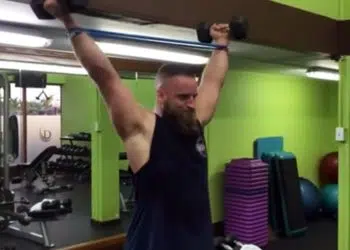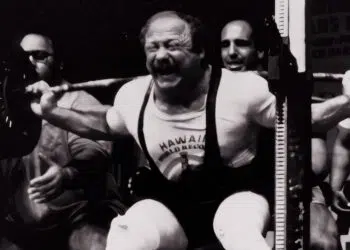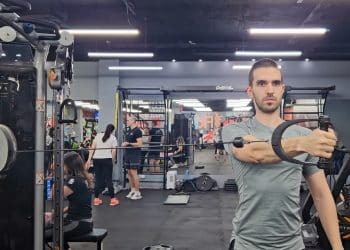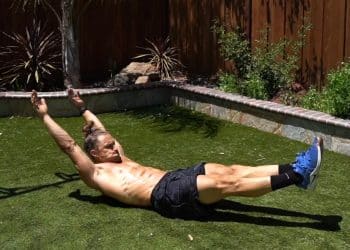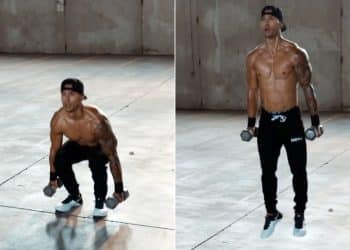The barbell clean and press isn’t your typical gym exercise. However, it’s an excellent full-body movement for building muscle, increasing strength, and developing explosiveness for athletic activities. In fact, the first portion of the movement (clean) is actually the first part of one out of the two lifts in weightlifting (clean and jerk).
Consequently, it’s a little more involved then the more common exercises that usually involve one single movement. Not the clean and press though, the bar starts from the floor and ends in the air above your head.
Here’s a guide to the clean and press…
Muscles Worked
The barbell clean and press works all muscles.
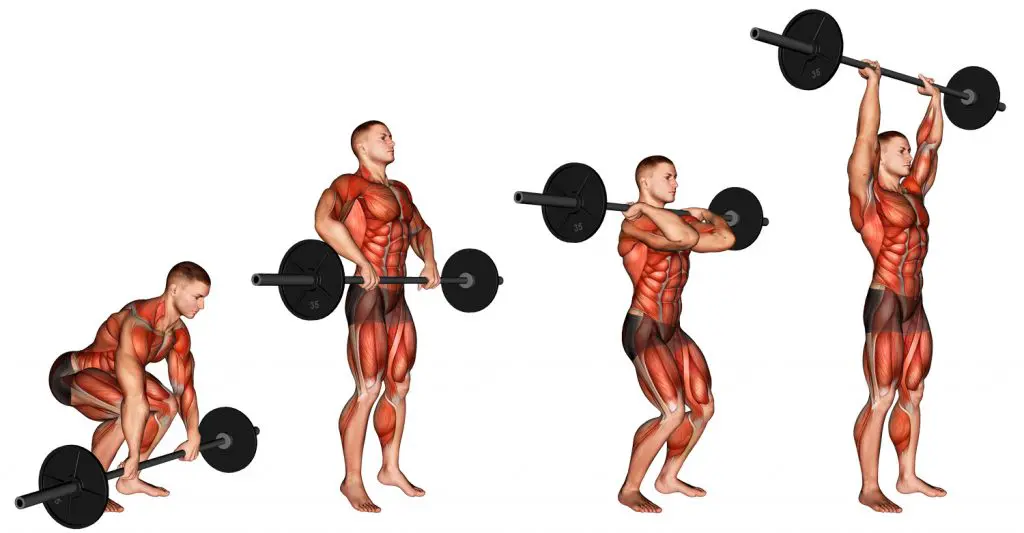
Shoulders
The overhead press which is the last portion of the lift engages the shoulders, more specifically, the anterior (front) and lateral (side) delts. The initial portion of the lift (clean) heavily involves the rear delts which must remain pinned back for a safe, efficient, and effective lift.
Legs
The clean is a deadlift, therefore, the legs must be engaged to drive the weight up off the floor. The glutes, hamstrings, and quads each play a respective role related to movement at the hips and knees.
Level Up Your Fitness: Join our 💪 strong community in Fitness Volt Newsletter. Get daily inspiration, expert-backed workouts, nutrition tips, the latest in strength sports, and the support you need to reach your goals. Subscribe for free!
Back
The muscles of the back (traps, rhomboids, lats, spinal erectors, etc) are also involved in the clean and press to a significant degree. They function to stabilize and keep the scapula retracted while also working to extend the spine under load.
Core
The core muscles (abdominals and oblique) are the bridge between the lower and upper body. Therefore, these muscles need to stay tight and rigid for optimal total body strength and performance. A strong core also protects the spine and back.
Arms
Because you’re obviously pulling with your arms, the biceps and forearms are very important during the first part of the lift. Then, the triceps assist in pressing the bar overhead.
Chest
The chest will also get some activation due to the overhead press. In fact, the press is a great movement for emphasizing the upper pecs.
How To Do The Clean and Press
Here’s a step-by-step for how to do the barbell clean and press safely and effectively.
- Walk under the bar so that it’s over the middle of your feet. Use a hip-width stance.
- Bend your knees and grip the bar with hands just outside of your legs as if you were setting up for a deadlift. Your upper legs should be slightly above parallel to the floor.
- Lean your torso forward by hinging at the hips and keep your back straight and core tight. Shoulders should be directly over the bar.
- Build tension between yourself and the bar by pressing your heels into the ground and then drive through your heels.
- As the bar reaches your knees, explosively extend the ankles, knees, and hips while simultaneously shrugging your shoulders pulling the bar upward. Your heels should leave the ground during this part but keep your toes on the ground.
- Drop down by bending your knees, catch the bar on your front delts and then move your elbows under the bar until your upper arms are parallel to the floor and your elbows are pointing straight ahead.
- Stand straight up and gather your stance by keeping your feet about hip-width and feet pointed slightly outward.
- Dip down slightly by bending your knees.
- Drive through the heels to explode up while shooting the hips forward to launch the bar overhead and finish with a press so that the bar is in line with your ears. Your shoulders should be pinned back so that the bar is stabilized overhead.
- Reverse the movement and repeat.
Tip: Start with a light weight and get the technique down before challenging yourself with heavier loads. This is for your safety and to make sure you’re getting the most out of the movement.
Here’s a video example…
4 Barbell Clean and Press Variations
Now for some variations that you can do…
Dumbbell clean and press
Dumbbells are always a great tool regardless of the exercise. One big benefit of using dumbbells is the obvious freedom of movement. However, dumbbells also offer the luxury of identifying left-to-right imbalances while also improving/developing stabilization, coordination, and balance.
Now, you won’t be able to lift as much weight overall, but each tool definitely has its pros and cons while also offering some obvious benefits.
Level Up Your Fitness: Join our 💪 strong community in Fitness Volt Newsletter. Get daily inspiration, expert-backed workouts, nutrition tips, the latest in strength sports, and the support you need to reach your goals. Subscribe for free!
Follow the same general technique of the barbell variation but place the dumbbells just outside of your feet. Also, feel free to use a neutral or overhand grip. Start light since more stabilization is required and then work your way up.
Kettlebell clean and press
Kettlebells are always a beneficial training tool as well due to how they’re constructed allowing the weight to move around the hand. Therefore, requiring even more stabilization and technique. But if done improperly, you can injure your hands and wrists.
Read on to learn how to do the kettlebell variation safely and effectively.
Single-arm clean and press
Whether you use a dumbbell or kettlebell, a single-arm variation of the clean and press has its advantages. Firstly, this is an effective method for correcting a left-to-right imbalance. Not to mention, training one side at a time is very effective for improving core strength and stability while improving total-body coordination and developing/improving functional movement patterns that carry over into athletic activities.
Place the single weight on the ground between your legs or a few feet in front of you for this variation. You can use a swing before the clean and press or you can lift the weight up in a straight line before doing the press.
To do the kettlebell variation:
- Place the kettlebell between your legs or in front of you with the handle horizontal so that you can use a pronated (overhand) grip.
- Keep your feet about hip-width apart or adjust based on what feels comfortable for you. Just don’t go too narrow or wide.
- Grip the kettlebell so that the handle is at a more diagonal angle in your palm rather than straight across (e.g. the handle should start high near the thumb and angle down to the bottom of the wrist directly under the pinky finger).
- Bring the kettlebell back as if you were doing a swing while bending your knees slightly.
- Thrust upward and pull the kettlebell up the center of your body as if you were zipping up your jacket then rotate your wrist so your palm is facing away from you. Your forearms should be mostly straight only at a slight angle toward the midline of your torso. You want the kettlebell to land softly between your forearm and bicep.
- Dip down and again, explode upward then press the kettlebell overhead keeping your arm close to your head. You could also just do a strict press without using your legs or hips.
- Reverse the motion and repeat.
If you prefer, you could drop the kettlebell down between your legs after the press as shown in the video you could lower it down to the ground.
Hang clean and press
Another great variation, the hang clean and press starts with the bar held on the thighs. You then lower the bar down the thighs toward the knees and then repeat the same motion as explained in the basic barbell clean and press instructions that we’ve provided.
How To Include The Clean and Press In Your Training Regime
Because the clean and press can be exhausting especially if using heavier weights, you might not want to do them with several other heavy compound movements in one session. Although, adding one or two may not hurt. But just allow yourself adequate time to recover.
It’s also good to do your sets first in a workout session when you’re fresh and at your strongest. This will not only allow you to lift more but there’s a better chance that you’ll prevent injury due to exhaustion which can affect your form. While this isn’t always a bad thing, you’re pressing a heavy bar overhead.
But there are many ways that you can incorporate the barbell clean and press. For example, you can add it to a basic resistance training routine, circuit training, HIIT (high-intensity interval training), CrossFit training, etc.
Sets/reps
3-5 sets could be sufficient depending on your goals. If you’re an athlete who competes then you likely have a routine already.
- If you’re training for strength, keep the reps low around the 4-6 rep range. Of course, only experienced lifters should lift this heavy to where reps are kept this low.
- For more of a focus on building muscle mass (although, you’ll still build muscle with 5-7 reps) and some strength, stick with 8-12 reps.
- Maybe you want to develop a combination of strength, muscular endurance, and mental fortitude. In that case, you can do anywhere from 15-30 reps.
Of course, mixing up your rep ranges is always good and there are benefits to be had with each one.
Wrapping Up
The barbell clean and press is a very useful exercise that can take your gains up a notch. It’s not the simplest of movements but practice with lighter weight and you’ll be doing it as part of your weekly workout regime in no time.
Interested in measuring your progress? Check out our strength standards for Hang Clean, Clean and Press, Clean, and more.


